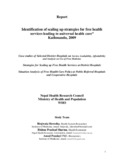Please use this identifier to cite or link to this item:
https://hdl.handle.net/20.500.14356/285| Title: | Report Identification of scaling up strategies for free health services leading to universal health care”Kathmandu, 2009 |
| Authors: | Nepal Health Research Council (NHRC), Ramshah Path, Kathmandu, Nepal |
| Issue Date: | 2009 |
| Publisher: | Nepal Health Research Council |
| Keywords: | Free Health Services Nepal |
| Abstract: | Introduction: Health policy of social inclusion: The Nepal Health Sector Programme (2004-2010)- is basically aimed at providing priority access to poor and vulnerable groups on a continued and sustainable fashion. The three year interim plan specifies the strategies for social inclusion. It also stresses the need for developing necessary policies and status to operationalize the concept of providing free basic health services so as to ensure the health right s of people as necessary steps towards extending universal access of basic health services to all people. The , 40- item medicines for PHCC and DH and the 32- item ones for HP/SHP are the chief initiatives taken toward that end as these medications are distributed free of cost upon presentation of prescription by patients. Similarly, the Aama program and the support to the uterine prolapsed patients are basically to reinforce the policy of ensuring the reproductive health right of women. Available health services at district hospitals for target groups (Poor, ultra poor, destitute, elderly, disabled, FCHV ), include provisions for safety nets for referral and poor patients, in catastrophic Illnesses- Cash Support (Rs.50000), and treatment support under social security program at referral hospitals. Additionally, some package policy exists for remote and isolated zones, districts, and for the terai regions. Rationale: Access to easy health services at district level hospitals for all ci tizens and secondary and tertiary levels of treatment is still related to the paying capacity of the service users. As the health service costs in these hospitals are still considerably higher than primary health care, service users are therefore forced to make a larger out of pocket payments(OOPE).. Because of this higher level of OOPE , the poor and vulnerable people are not able to access the health services at this level. Thus, capacity to pay has remained a major barrier to those seeking to utilise the existing health care facilities at an affordable cost. At the district hospitals, only some targeted groups can access the free health care services. In the light of these prevailing scenario, it is now absolutely necessary to scale up the current free health care services so as to ensure and expand the accessibility and affordability of these services for the poor and the vulnerable groups . This study is, therefore, aimed at identifying the strategies and on the basis of which to make suitable recommendations with the hope that these would help the planners at the central level to scale up the free health care services at district level hospitals and also at the same time help them undertake the time-suited situation analysis of the possible referral hospitals. .Objectives: The overall objective of the proposed activity is to develop options and strategies for effective scaling up of the FHC program at various levels of health service institutions. Specific Objectives: 1) To identify the scaling up strategies for free health services in District Hospitals., 2) To explore the key issues for the management process of free health care service facilities in three selected referral hospitals (central and zonal hospital) and 3) to conduct situati on analysis on the cooperative- based health facilities/ hospitals and policy and mechanisms for free health service delivery. Methodology: The study was conducted in three designs 1) Study and cost analysis of district-level hospitals 2) study of referral hospitals on free health care and 3) Study of cooperative- based hospitals on health finance policy and its actual implementation. The study period is between July to October 2009. The study was conducted in the following District Hospitals: Rupandehi, Gorkha, Nuwakot, Bardiya, Sunsari, Baitadi, Referral hospitals: Central Hospital: NAMS Bir Hospital, Lumbini and Koshi Zonal Hospital. Cooperative Hospitals which were under study included: Manamohan Memorial Community Hospital and STUPA Community Hospital in Katmandu. The findings of the study are limited to exploring the current situation of the service provisions at district level hospitals, (primary data) with the cost analysis based on secondary data. Similarly, information collected and presented here on the referral and cooperative hospitals are limited to providing brief description of the existing provisionsfor health financing and for free health care. |
| URI: | http://103.69.126.140:8080/handle/20.500.14356/285 |
| Appears in Collections: | NHRC Research Report |
Items in DSpace are protected by copyright, with all rights reserved, unless otherwise indicated.

